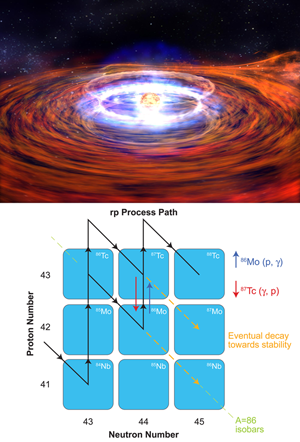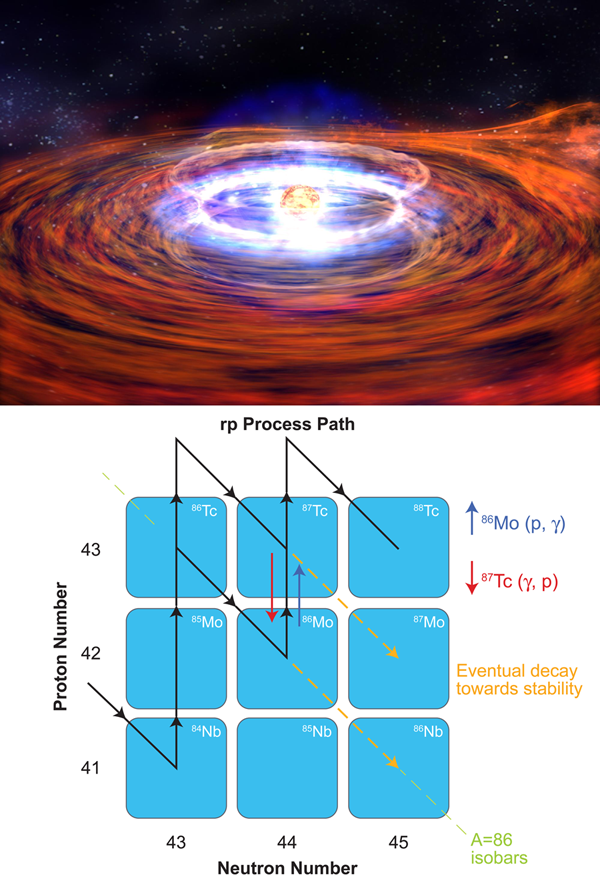Putting rare isotopes on the scale
In binary star systems consisting of a neutron star and a less-evolved companion (Fig. 1, top), material rich in hydrogen and helium can transfer onto the neutron star surface. There, it is compressed and heated to extremely high temperatures that facilitate thermonuclear runaways. (The runaways are triggered by the energy released in the triple-alpha nuclear reaction and other “break out” nuclear reactions from the so-called hot carbon-nitrogen-oxygen cycle [1].) The explosions are known as type-I x-ray bursts because they release a large flux of x rays that is detectable as a sharp rise in x-ray luminosity, followed by a slower decay.
Most of the bursts’ energy comes from a series of nuclear reactions that occur by what is called the rapid proton capture process (or, process): Protons fuse with seed nuclei in quick succession, synthesizing isotopes in a zigzag path of proton fusions and inverse beta decays near the proton drip line—the limits of nuclear existence beyond which nuclei simply cannot bind another proton. At the end of such an outburst, the remaining nuclei in the path decay and populate nuclei towards the line of stability. The process thus enhances the abundance of specific elements in the ashes on the surface of the neutron star and even determines some of the observational properties of x-ray bursts, such as the size and shape of the luminosity profile over time. Since the luminosity can be linked to the neutron star’s mass, understanding the nuclear reactions that contribute to the x-ray bursts is crucial [2,3]. There is another reason to study the process: If material synthesized during an x-ray burst escapes the gravitational field of the neutron star and is flung into the interstellar medium, it could potentially be one source of specific chemical elements in the galaxy whose origins are otherwise difficult to explain. Examples include a number of proton-rich stable nuclei, such as molybdemum- or ruthenium- .
Efforts to simulate the path of nucleosynthesis in the process and understand the production of these isotopes rely heavily on nuclear physics data, such as the masses, half-lives, and capture rates of various unstable nuclei. The masses, or more specifically the proton separation energies (the energy it takes to remove one proton from a nucleus) play a particularly decisive role. At present, the uncertainty in the experimentally determined masses of many unstable nuclei are significant (in contrast, theoretical predictions for masses of stable nuclei are very good). However, improving the measurements for the nuclei close to the drip lines—the ones most important for the process—is difficult. Simulations of the zigzag production path are altered according to the assumed masses (separation energies), predicting final abundances that vary by as much as an order of magnitude between calculations.
One of the main goals for the ion-trap facility SHIPTRAP, housed at the GSI Helmholtz Centre for Heavy Ion Research in Darmstadt, Germany, is to improve the mass measurements of the unstable nuclei involved in the process. In a paper appearing in Physical Review Letters [4], an international team of scientists working at SHIPTRAP report mass measurements—some of which are the first—of proton-rich isotopes in the vicinity of mass ( ) (Fig. 1, bottom). This region lies near molybdenum- —a so-called waiting point nucleus, because it is a nucleus where the radiative capture of protons competes with the reverse photodissociation reaction, and flow “upward” in the nuclear chart is essentially halted, favoring instead a slower beta decay process. Better mass measurements in this region could help predict the amount of energy produced in certain -process paths, and in turn, how high a temperature can be reached in an x-ray burst. This in turn determines which elements could be produced in, for example, a so-called ZrNb cycle—a cycle that takes an excited nuclear state through a series of captures and decays to return to its starting point and has the effect of inhibiting nucleosynthesis up to higher masses.
The heart of the experiments at SHIPTRAP is a Penning ion-trap mass spectrometer—the most accurate and precise instrument for determining the mass of short-lived isotopes. Penning traps are nowadays the workhorse for precision mass measurements, and are employed at virtually all facilities where rare beams are produced. In these ion traps (for which the 1989 Nobel prize was given to Hans Dehmelt and Wolfgang Paul) the cyclotron frequency with which charged particles orbit in a combined electric and magnetic field is measured, and from that their mass derived (via ). Penning traps have now been technically advanced to enable experiments on almost all available rare isotopes, from very short-lived isotopes (lithium , which has a half-life of ms [5] to Super Heavy Elements (SHE) [6], which are produced in minuscule quantities of a few ions per minute or less.
The SHIPTRAP team measured the masses of ten neutron-deficient nuclei, which were produced in a fusion-evaporation reaction at the GSI SHIP velocity filter (a unique source for the relevant nuclei). The filter separates the reaction products in flight and the beam of remaining products is stopped in a gas cell. From there, the ions are extracted and delivered to the ion trap system where their masses are determined with a relative precision of to , or about to absolute uncertainty (one atomic mass unit is about ). The team finds low alpha-separation energies (the energy required to remove an alpha particle from the nucleus) compared to what had been predicted and found for these nuclei previously. And with these precise mass values of the nuclei, the team is able to perform a reevaluation of the mass landscape within a specific region of the nuclear chart. They obtain a homogeneous picture of the masses, without the artificial jumps or gaps that result from unmeasured masses. Based on their data, they recalculate an process similar to what is expected in an x-ray burst stellar scenario. They find that once they include their new mass values, the resulting production at mass number is changed by a factor , the largest change ever found in an -process calculation, once new experimental results have been included. This surprising result underscores the need for high-quality nuclear physics data.
Interestingly, similar mass measurements [7] performed at the new Cooler Storage Ring at the Heavy Ion Research Facility in Lanzhou, China, show the measured proton separation energy for arsenic- differs from theoretical predictions. The authors also cast doubt on the expectation that germanium- is a waiting point nucleus. Although their measurements are less precise than the Penning trap methods performed at GSI, this team’s results are also leading to new conclusions about the process.
The SHIPTRAP team also observes a shift of the mass landscape towards more proton-rich nuclei, in which protons are more loosely bound. The process seems to favor this path and it leads to a change in the remaining abundance of isotopes with and the indirect progenitors of the key isotope molybdenum- ( of molybdenum). Moreover, their newly discovered low alpha-separation energies suggest the production cycle is favored, which will allow one to put a limit on the energy and temperature availability in the process. To further explore this and put tighter constraints on such possibilities, more direct mass measurements, in particular for zirconium- , zirconium- , niobium- , and of course molybdenum- , are needed as they play a key role in the understanding of the process and the reach and limit of the element production in such a scenario.
Understanding the nucleosynthesis and energetics of x-ray bursts requires an interdisciplinary approach between astronomical observations, astrophysics models and calculations, and a good understanding of the underlying nuclear physics. This paper shows the surprising insights that come from precision measurements of a few (but key) nuclear physics properties.
References
- M. Wiescher, Physics 2, 69 (2009)
- Michael Wiescher and Hendrik Schatz, Prog. Theor. Phys. Suppl. 140, 11 (2000)
- H. Schatz and K. E. Rehm, Nucl. Phys. A777,601 (2006)
- E. Haettner et al., Phys. Rev. Lett. 106, 122501 (2011)
- M. Smith et al., Phys. Rev. Lett. 101, 202501 (2008)
- M. Block et al., Nature 463, 785 (2010)
- X. L. Tu et al., Phys. Rev. Lett. (to be published)





